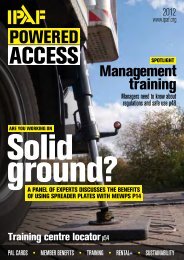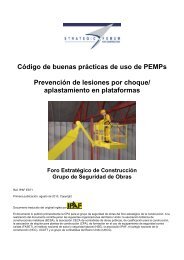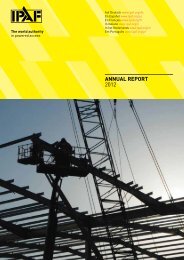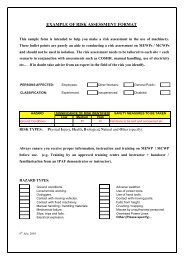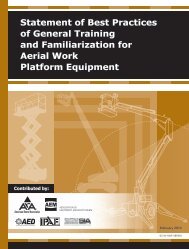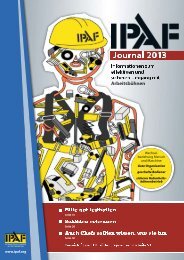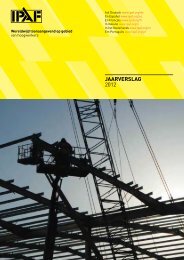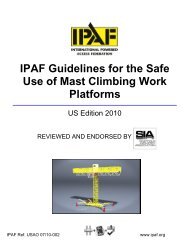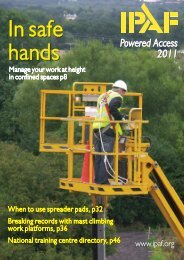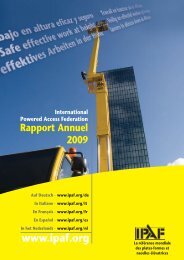Create successful ePaper yourself
Turn your PDF publications into a flip-book with our unique Google optimized e-Paper software.
“You can<br />
count on one<br />
hand the<br />
amount of<br />
reportable<br />
incidents<br />
that have been reported<br />
to the HSE in the past<br />
10 years. Can that be<br />
said about many other<br />
access industries?”<br />
Cameron Reid<br />
continued from page 33<br />
a particular way. Each manufacturer<br />
has its own specifics, but one MCWP<br />
product is not vastly different from the<br />
other, just like a Volkswagen Golf is not<br />
entirely different from a Ford Focus. The<br />
same safety measures apply.”<br />
While the old course had six modules,<br />
the new course now has 28 smaller,<br />
bite-sized, simplistic modules that are<br />
easy to deliver and assess. It is no more<br />
and no less detailed than the previous<br />
course, says Reid, but the new course<br />
makes a clearer distinction between<br />
two sets of skills: literacy and manual<br />
dexterity.<br />
Course categories<br />
MCWP training covers the categories<br />
Mobile Operator, Demonstrator, Installer<br />
and Advanced Installer, each leading to<br />
the award of an MCG-recognised PAL<br />
Card (Powered Access Licence).<br />
The advanced category takes the<br />
installer beyond building and installing<br />
machines. An advanced installer is<br />
trained as a manager or supervisor, with<br />
the ability to plan, to carry out a risk<br />
assessment of a job, to compile method<br />
statements and to configure special<br />
arrangements, including special tie and<br />
anchor specifications. He or she is also<br />
trained to carry out thorough examinations<br />
in accordance with LOLER,<br />
the Lifting Operations and Lifting<br />
Equipment Regulations 1998.<br />
There is another category, User, which<br />
does not require the issuing of a PAL<br />
Card. This is essentially an induction<br />
course that is conducted by a certified<br />
demonstrator. Users, those who work on<br />
MCWPs, are also not required to have<br />
specific certification, other than a clear<br />
understanding of the machine’s operating<br />
controls.<br />
“The demonstrator is the key<br />
figure when MCWPs are used on<br />
site,” says Reid. “He or she is the<br />
appointed person on site who can<br />
induct a user. You will typically find<br />
more demonstrators on site than the<br />
other categories. They are the people<br />
who know the parameters of the<br />
product, who ensure that they are<br />
dismantled, serviced and used in the<br />
proper way.<br />
“Once a user is inducted, he or she<br />
should have no problems operating the<br />
up/down controls, being able to carry<br />
out a pre-use check and understanding<br />
AWPT leads on mastclimber safety<br />
what procedures to follow in the case of<br />
an emergency.”<br />
Reid says: “My advice to site managers<br />
is: no cowboys on site, conform to<br />
local regulations and ensure that your<br />
employees are competent and properly<br />
trained under a certified and internationally<br />
recognised training programme,<br />
such as <strong>IPAF</strong>.<br />
“You can count on one hand the<br />
amount of reportable incidents that<br />
have been reported to the HSE in the<br />
past 10 years. Can that be said about<br />
many other access industries? If everyone<br />
followed the regulations, training<br />
requirements and recommended<br />
practices, this would be an even safer<br />
worldwide industry.”<br />
AWPT, <strong>IPAF</strong>’s North American subsidiary, has met with officials from the city<br />
of Boston and the state of Massachusetts to review safety issues in the use of<br />
MCWPs, following an accident that resulted in three deaths.<br />
Kevin O’Shea of Mastclimbers LLC made a presentation to the Massachusetts<br />
Chapter of the Association of General Contractors (AGC) in June 2006. O’Shea<br />
is working with AWPT to spearhead the AWPT MCWP training programme in<br />
North America. More than 140 delegates attended the talk, including legal and<br />
safety experts, access specialists and safety directors from major companies<br />
such as Bovis Lend Lease, Lee Kennedy and Skanska.<br />
Three key points emerged from the discussion:<br />
1. Although a design standard for MCWPs is currently being re-drafted in<br />
the US, there is no specific regulation for ‘Installation, Maintenance, Thorough<br />
Examination and Safe Use’ as there is in Europe.<br />
2. There is no independent assessment, policing and verification of operator<br />
skills.<br />
3. There is a lack of accountability throughout the supply chain.<br />
An analysis of MCWP incidents around the world in the past 10 years shows<br />
that most probably could not have been prevented by inspection. Human error<br />
during use, erection/dismantling and risk assessment is a far more likely cause.<br />
Only through proper training can most accidents be avoided.<br />
Trainees are<br />
put through<br />
their paces<br />
on an MCWP<br />
training<br />
course.<br />
34<br />
<strong>IPAF</strong> POWERED ACCESS REVIEW 2007







